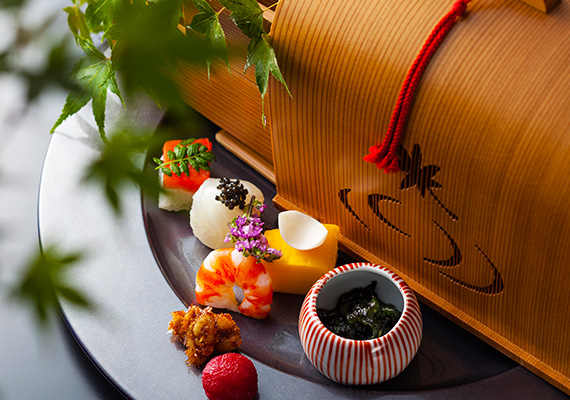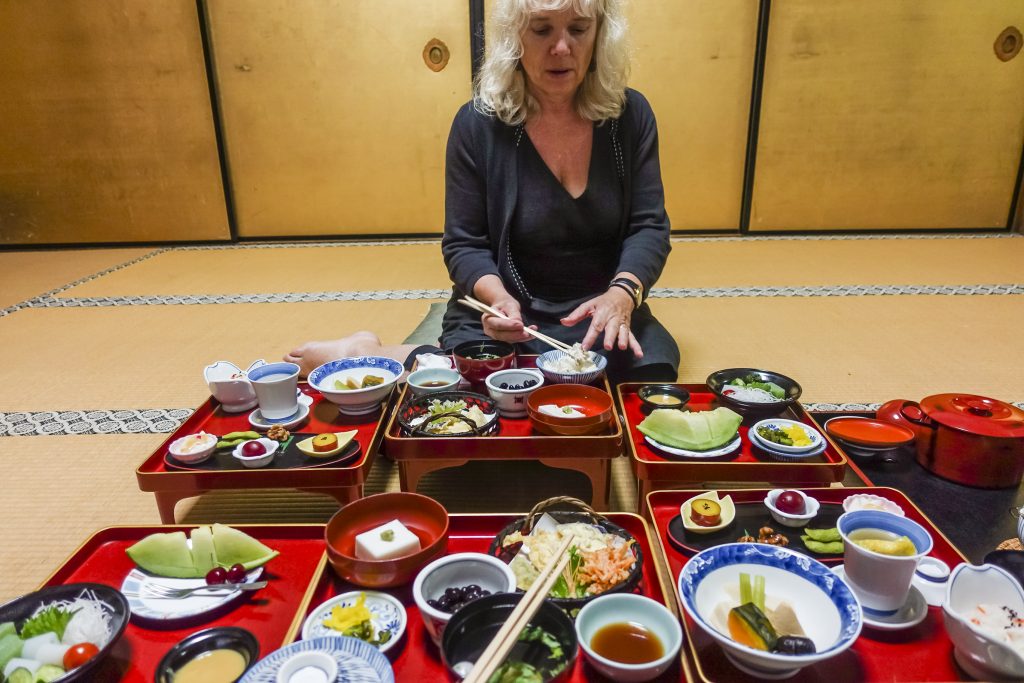For Japanese people, what they eat is very important. So many times, after a regional trip, the first question I was asked was: “So what did you eat?”
Talking about Japanese cuisine (和食, washoku) could be an endless story since it offers so many delicious dishes. Japanese food is both regional and seasonal. Like with the Japanese architecture, the Japanese cuisine is a perfect combination of tradition and modern styles. Restaurants in Japan range from street food stands to centuries old traditional ones. Many restaurants are specialized in a single type of dish, while others offer a variety of dishes.
Kaiseki at a Ryokan
At a Japanese ryokan, one of the highlights is dining on “kaiseki” (a traditional, multi-course dinner). Indeed, many Japanese think of a ryokan as a place to dine on “kaiseki” rather than as a type of accommodation. One Kyoto ryokan owner told me that over 70% of his income was from his diners while the rest came from overnight guests. What exactly is kaiseki? The term “kaiseki” means hot stone in a kimono fold, and it is believed that Zen priests would tuck hot stones wrapped in towels next to their stomach to cure their hunger pangs during their morning and afternoon prayers (the term “kai” means a fold in a kimono and “seki” means stone). In this way it was believed that only a small amount of kaiseki would be enough to take away your hunger. Originally, kaiseki was a simple, vegetarian meal served during the traditional tea ceremony. It was thought the tea would taste better if the guests were not so hungry. Today kaiseki is no longer a strictly vegetarian meal but may also include both meat and fish.
One kaiseki dinner can consist of anywhere from 6 to 15 different kinds of food.

Street Food “Yatai”
Japan will test all your senses, and its street food scene is no exception. Yatai are small food stalls that can be found at festivals or near train Stations. Yatai are a great way to deeply discover Japan. These vendors offer an accessible and tasty selection of on-the-go dishes that are cheap, high-quality and delicious. Yatai will offer you dishes such as Takoyaki, Yaki Soba, Yakitori,…
Our favorite destinations for Yatai are Osaka and Fukuoka.
Kobe Beef in Kobe
Kobe Beef is a fancy Japanese delicacy and probably the most widely-known regional specialty food in Japan. It is one of several brands of Wagyu (Japanese beef), which are bred throughout the country and often associated with the area where they are raised. While Kobe Beef is probably the best known type of wagyu outside of Japan, there are many other breeds, such as Matsuzaka and Yonezawa Beef, that are equally or even more famous among Japanese gourmets.
When passing by Kobe, don’t miss to taste Kobe Beef!

Michelin Starred Restaurants in Tokyo
Japan is one of this place where foodies will cross continents only for its renowned restaurants. Among Japanese cities, Tokyo is the best place to experience a Michelin starred restaurant without a doubt.
In 2020, 11 restaurants in Tokyo get 3 Michelin stars, and there are 226 Michelin-starred restaurants in Tokyo totally. And then, it is really difficult to make a decision about where to eat in Tokyo; your Japan Expert will guide you.
Shojin-Ryori
Shojin-Ryori consists of the traditional dining style for Japanese monks. Meals are composed of numerous small bowls and dishes on a red lacquer tray, set about six inches off the floor. You will usually have to sat cross-legged on thin cushions to eat it. The menu consists of vegetables, two kinds of tofu, miso soup, pickles and a savory custard. A generous container of rice provides additional sustenance. Dessert is a usually fruits (they tolerate tropical fruits such at pineapple,…). Unlike most other meals in Japan, there is no fish, and certainly no meat. Fortunately, the sect’s rigorously vegetarian diet permits beer which is greatly appreciated after a busy day sightseeing.

Special Meal Requirements
Meals requirements are not expressed in the same way all over the world. We want to make sure that we understand your needs, so we can communicate them clearly to the place reserved.
If you have any special meal requirements like Celiac, allergies, vegetarian with fish, vegan, or specific foods that you cannot eat, then you must tell us as soon as possible. Please keep in mind that special meal requirements will limit the number of restaurants or hotels/ryokans available to you and it may be impossible to find one for you. Of course we will do our best to find a place that can prepare meals for you.
Please find more details see our Special Meal Requirements page.




